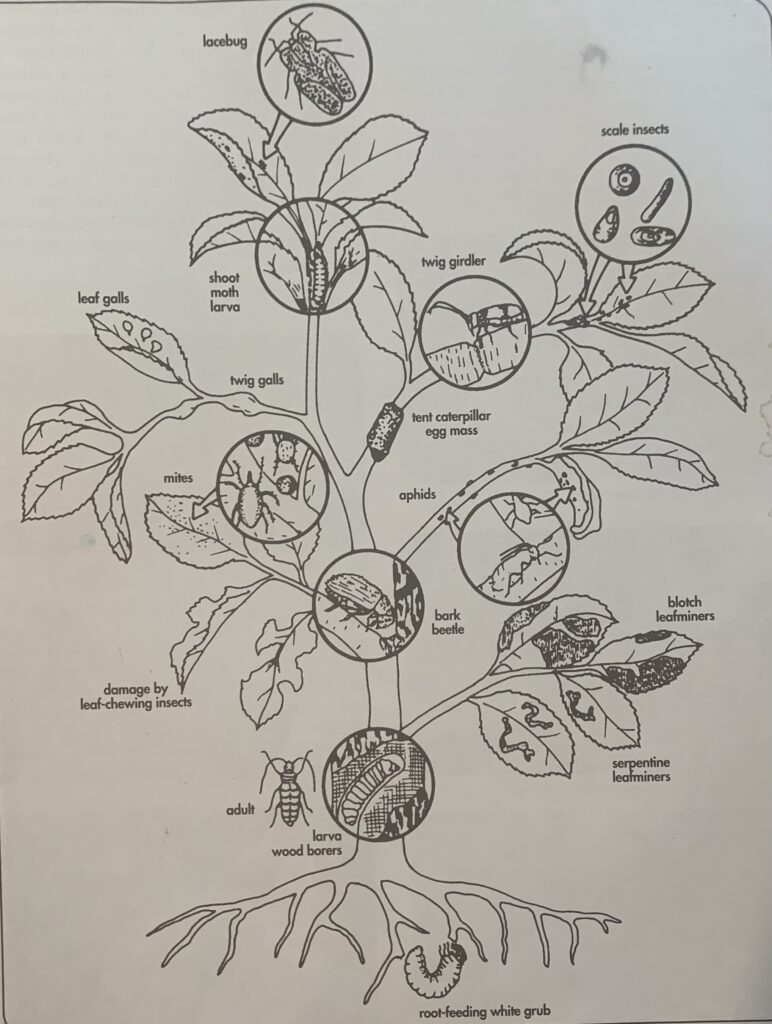Plant Health Care ( PHC )
Insect and Disease Control
Our PHC is a holistic and comprehensive program to manage the health, structure, and appearance of plants in the landscape.
An important part of a successful PHC program is monitoring the plants and growing conditions of stress factors that can head off more serious problems in the future.
Five components are Key to successful integrated pest management.
- Prevention
- Pest and Symptom identification
- Regular Surveying for pests
- Action Thresholds and guidelines
- Sound management methods
The IPM includes the application of horticultural oils to ornamental plants. the pesticidal action of oils is mainly physical: oils block the spiracles (respiratory openings) and prevent the exchange of gases for metabolic processes. The residual film may inhibit scale crawlers from attaching to plant tissue
Oils applied during the dormant season are used to control scale insects, mites, mites eggs, aphid eggs, psylla, whiteflies, thrips, and beetle larvae.
Various insects and the injuries they cause.

From the Arborist Certification Study Guide
Disease
Plant diseases occur when three critical elements come together to make a disease triangle The are pathogen, susceptible Host plant, and a favorable environment.
There is a common disease in ornamental plants:
- Powdery Mildew
- Gray Mold
- Rust
- Leaf Spot Diseases
- Tip Blights
- Anthracnose Diseases
- Canker Diseases
- Leaf Galls
- Wilt diseases




THREE AND SHRUB CARE PROGRAM
Treatment #1 Horticultural Oil (Inspection and Insect Control) / February-April
Early spring, liquid application of horticultural Oil to control insect’s eggs, larvae,
and some scales through suffocation.
Treatment #2 Foliar Fertilization, Inspection / Late March – April.
Visual Inspection of every tree and shrub on the property. Spring fertilization provides all the essential nutrients for optimum plant growth.
Treatment #3 Inspection and Insect, mite, and disease control / Late April – May.
Inspection of every tree and shrub on the property. Foliar spray of trees and
shrubs that need treatment. This treatment includes control of mites, insects: like
aphids, psyllids, Japanese beetles, and scales. Diseases caused by fungus-like leaf
spots, powdery mildew.
Treatment #4 Inspection and Insect and disease control / June.
Inspection of every tree and shrub on the property. Late spring liquid treatment of
insecticide and fungicide to control insect and disease problems. This foliar spray
controls aphids, bagworms, psyllids, and some scales.
Treatment #5 Inspection and Insect, Mite, and disease control. July.
Inspection of every tree and shrub on the property. Summer foliar spray to control
mites, insects, and diseases to all trees and shrubs needing treatment.
Treatment #6 Inspection and Disease, insect and mite control / August – September.
Inspection of every tree and shrub on the property. Late Summer foliar treatment
to control: mites, insects, and diseases on susceptible ornamental plants.
Treatment #7 Root Fertilization / November – December
Liquid Drench fertilization to provide nutrients that are lacking in an urban
environment.